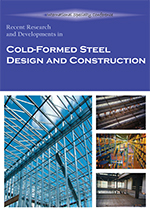Session Dates
24 Aug 2012 - 25 Aug 2012
Abstract
The first experimental phase of the NEES Nonstructural Grand Challenge Project: “Simulation of the Seismic Performance of Nonstructural Systems” investigated the in-plane hysteretic behaviors of thirty-six full-scale cold-formed steel framed gypsum partition walls. Results of quasi-static reverse cyclic and dynamic testing on sixteen wall configurations including walls with commercial and institutional construction details and innovative connection techniques are first briefly reviewed. Thereafter, six tri-linear hysteretic models of partition walls with pinching behavior and strength and stiffness degradation are developed based on the experimental data for use in a finite element analysis platform. The partition wall models, represented by shear spring elements at each floor level, are incorporated into a numerical model of a four story steel moment frame medical facility. Although nonstructural components are required to carry self-imposed loads and minimal external loads and are not required to be considered in the structural analysis and design of buildings, the addition of the partition walls are shown to increase the stiffness and strength of the building, reducing the natural period by more than 11%. Furthermore, partition walls are shown to introduce over 42% more damping into the building due to the continual energy dissipation through their pinched hysteretic behaviors. The effect of the nonstructural partition walls on the inter-story displacements and absolute accelerations is also examined.
Department(s)
Civil, Architectural and Environmental Engineering
Research Center/Lab(s)
Wei-Wen Yu Center for Cold-Formed Steel Structures
Meeting Name
21st International Specialty Conference on Cold-Formed Steel Structures
Publisher
Missouri University of Science and Technology
Document Version
Final Version
Rights
© 2012 Missouri University of Science and Technology, All rights reserved.
Document Type
Article - Conference proceedings
File Type
text
Language
English
Recommended Citation
Davies, Ryan; Retamales, Rodrigo; Mosqueda, Gilberto; Filiatrault, Andre; and Allen, Don, "Effects of Cold-formed Steel Framed Gypsum Partition Walls on the Seismic Response of a Medical Facility" (2012). CCFSS Proceedings of International Specialty Conference on Cold-Formed Steel Structures (1971 - 2018). 6.
https://scholarsmine.mst.edu/isccss/21iccfss/21iccfss-session10/6
Effects of Cold-formed Steel Framed Gypsum Partition Walls on the Seismic Response of a Medical Facility
The first experimental phase of the NEES Nonstructural Grand Challenge Project: “Simulation of the Seismic Performance of Nonstructural Systems” investigated the in-plane hysteretic behaviors of thirty-six full-scale cold-formed steel framed gypsum partition walls. Results of quasi-static reverse cyclic and dynamic testing on sixteen wall configurations including walls with commercial and institutional construction details and innovative connection techniques are first briefly reviewed. Thereafter, six tri-linear hysteretic models of partition walls with pinching behavior and strength and stiffness degradation are developed based on the experimental data for use in a finite element analysis platform. The partition wall models, represented by shear spring elements at each floor level, are incorporated into a numerical model of a four story steel moment frame medical facility. Although nonstructural components are required to carry self-imposed loads and minimal external loads and are not required to be considered in the structural analysis and design of buildings, the addition of the partition walls are shown to increase the stiffness and strength of the building, reducing the natural period by more than 11%. Furthermore, partition walls are shown to introduce over 42% more damping into the building due to the continual energy dissipation through their pinched hysteretic behaviors. The effect of the nonstructural partition walls on the inter-story displacements and absolute accelerations is also examined.



